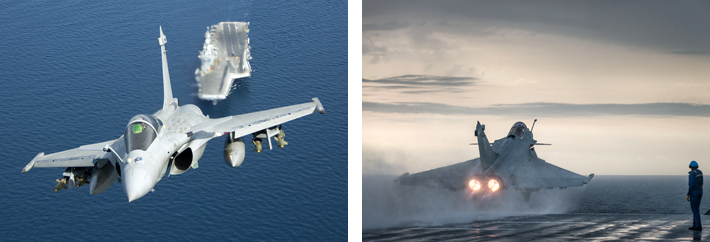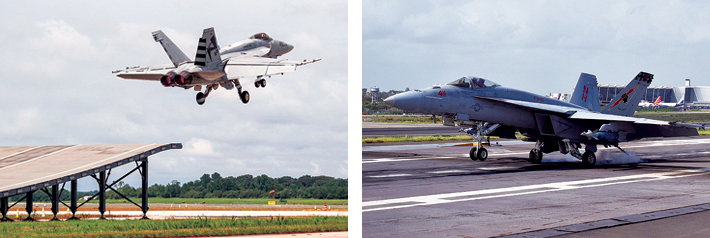INDIAN ARMED FORCES CHIEFS ON
OUR RELENTLESS AND FOCUSED PUBLISHING EFFORTS

SP Guide Publications puts forth a well compiled articulation of issues, pursuits and accomplishments of the Indian Army, over the years

I am confident that SP Guide Publications would continue to inform, inspire and influence.

My compliments to SP Guide Publications for informative and credible reportage on contemporary aerospace issues over the past six decades.
Navy's Fighter – Rafale or F/A-18?
Tests of the French Rafale and the American F/A-18 Super Hornet took place from late May to June at the Indian Navy's test site at Hansa Air Base in Goa
 |
The Author is Former Director General of Information Systems and A Special Forces Veteran, Indian Army |
The race for selecting a fighter aircraft for Indian Navy’s aircraft carriers has been described in these columns earlier, with the French Rafale and the American F/A-18 Super Hornet competing in the trials to emerge as the winner. It was also mentioned that the Navy has to choose a fighter aircraft for the interim period till the Defence Research and Development Organisation (DRDO) develops the indigenous Twin Engine Deck Based Fighter (TEDBF) jet whose operationalisation and induction into the Navy would likely take few years time. The TEDBF, which will not be a stealth fighter, is supposed to fly within six years (by 2028) with induction of the fighter inside a decade, by 2030.
The main requirement of the Indian Navy for a new carrier-based fighter is for it to take off when fully loaded with fuel and weapons, including precision-guided bombs and nuclear-powered systems. The winner is to receive a contract for 24-26 aircraft for the new aircraft carrier, while government reportedly plans to order 57 x carrier-based fighters, some of which are to replace the old Soviet MiG-29K/KUB.
The main requirement of the Indian Navy for a new carrier-based fighter is for it to take off when fully loaded with fuel and weapons, including precision-guided bombs and nuclear-powered systems
The French Rafale-M and the American F/A-18E Super Hornet reached the final of the Indian tender for the supply of fighters for the new aircraft carrier. The Russian MiG-29K/KUB did not make it further in the trials. Tests of the French Rafale and the American F/A-18 Super Hornet took place from late May to June at the Indian Navy's test site at Hansa Air Base in Goa, which simulates the deck of the Indian aircraft carrier INS ‘Vikrant’.

According to Boeing, the F/A-18 Super Hornet fighters demonstrated to the Indian Navy the ability to take off from the deck of an aircraft carrier with an increased load. As part of the test, the F/A-18E Super Hornet fighters took off with two AGM-84 Harpoon anti-ship missiles, which exceed the requirements of the Indian Navy for new carrier-based fighters.
The French Carrier Air Group (Le Groupe Aérien Embarqué) operates three squadrons (11F, 12F, 17F) of 15 x Rafale M aircraft each, and one squadron (4F) of 3 x E-2C Hawkeye aircraft. The US Navy has the world's largest carrier fleet with 11 nuclear-powered ships, each carrying roughly 80 warplanes. The service also boasts two of the world's best carrier-based fighter jets — the F/A-18 Super Hornets and the F-35 stealth fighter jets.
The trial reports of the Rafale M and F/A-18 Super Hornet have been forwarded to the Ministry of Defence (MoD) by the Indian Navy and a decision would possibly be announced in about a month from now
Alain Garcia, Vice President, India business development, Boeing Defense, Space & Security and Global Services, has said, “With the Super Hornet Block III, the Indian Navy would not only get the most advanced platform but would also benefit from tactics, upgrades, and knowledge related to the naval aviation ecosystem that the US Navy offers.” But same would also be the case for the Rafale M. The Indian Navy would similarly also benefit from tactics, upgrades, and knowledge related to the naval aviation ecosystem that the French Navy offers.
The advantage in favour of the F/A-18E Super Hornet is the demonstrated ability to take off from the deck of the aircraft carrier with additional load from what the Navy had mandated. In the case of the Rafale M, the Indian Air Force is already flying Rafale aircraft and French aerospace major Safran is expanding in India, including establishing a maintenance and repair facility in India. In addition Safran and Hindustan Aeronautics Limited (HAL) have signed a memorandum of understanding on military engine collaboration announcing their intent to work together on bringing niche engine technology to India. A significant amount of transfer of technology (ToT) is also contemplated in the assembling and manufacturing programme.

The trial reports of the Rafale M and F/A-18 Super Hornet have been forwarded to the Ministry of Defence (MoD) by the Indian Navy and a decision would possibly be announced in about a month from now. Whether there are political considerations in the final selection (keeping both France and the US happy) or not, the government will have to weigh in the pros and cons of selecting the F/A-18 Super Hornets for the Navy while the IAF flies the Rafale, with the F/A-18 taking of the carrier deck with additional weight over and above the requirement mandated by the Navy, or go for the Rafale M in consideration of uniformity, collaboration and ToT in engine technology, plus repair and maintenance facilities.
Since contract for the fighter jets would be inked on government-to-government basis, the Navy hopes to begin the procurement process by the end of this year
Whatever the case, it would be prudent for the MoD should take the decision on the Rafale M vis-a-vis F/A-18 Super Hornets early. The INS ‘Vikrant’ air wing will include 26 x fighters jets and 10 x helicopters. Since contract for the fighter jets would be inked on government-to-government basis, the Navy hopes to begin the procurement process by the end of this year.
Meanwhile, the Indian Navy on July 28 took delivery of the country's first indigenously built aircraft carrier 'Vikrant' from its manufacturer, Cochin Shipyard Ltd, ahead of its scheduled commissioning next month.





